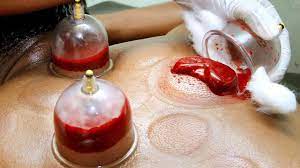Hijama, also known as cupping therapy, is an ancient form of alternative medicine that has been practiced for centuries across various cultures. This therapeutic procedure involves creating suction on the skin using cups to promote healing and relieve various ailments. While Hijama treatment is commonly performed on the back, it can also be beneficial when applied to the belly area. In this article, we will explore the procedure for Hijama treatment on the belly, its benefits, and what to expect during and after the session.
Understanding Hijama Treatment
Hijama Treatment involves the use of cups placed on specific areas of the body to create suction. The cups can be made of various materials, including glass, bamboo, or plastic. By creating a vacuum, Hijama draws blood to the surface of the skin, stimulating the flow of energy and promoting healing. This therapy is based on the principles of traditional Chinese medicine and is believed to help balance the body's energy pathways, known as meridians.
Points:
Brief overview of Hijama treatment.
Mention of the cups used and their materials.
Explanation of the therapeutic mechanism based on traditional Chinese medicine principles.
Benefits of Hijama Treatment on the Belly
Hijama treatment on the belly offers a range of potential benefits for both physical and emotional well-being. Here are some of the key advantages:
1. Digestive Health Improvement
Hijama applied to the belly area can stimulate digestive organs, promoting better digestion and relieving issues such as bloating, gas, and indigestion. By increasing blood flow to the digestive system, Hijama may help enhance nutrient absorption and alleviate discomfort associated with gastrointestinal issues.
Points:
Hijama treatment aids in improving digestion.
It helps in relieving bloating, gas, and indigestion.
Enhanced blood flow can lead to better nutrient absorption.
2. Hormonal Balance
The belly area is closely linked to the reproductive organs and endocrine system. Hijama treatment on the belly may help regulate hormone levels, particularly in women experiencing menstrual irregularities or hormonal imbalances. By promoting blood circulation and removing stagnant blood, Hijama can support hormonal balance and alleviate symptoms associated with hormonal fluctuations.
Points:
Hijama treatment can help regulate hormone levels.
It may alleviate symptoms of menstrual irregularities.
Promotion of blood circulation aids in hormonal balance.
3. Stress Reduction
The belly area is also associated with emotions and stress. Hijama treatment on the belly can help release tension and stress held in the abdominal muscles, promoting relaxation and a sense of well-being. By improving blood flow and energy circulation, Hijama may help reduce stress levels and promote mental clarity.
Points:
Hijama treatment on the belly aids in releasing tension and stress.
It promotes relaxation and a sense of well-being.
Improved blood flow leads to reduced stress levels.
The Procedure for Hijama Treatment on the Belly
The procedure for Hijama treatment on the belly typically follows these steps:
1. Consultation
Before the Hijama session, a practitioner will conduct a consultation to assess your health history, current symptoms, and any specific concerns you may have. This consultation helps determine the appropriate Hijama technique and areas to target during the treatment.
Points:
Consultation is conducted to assess health history and concerns.
It helps determine the suitable Hijama technique and target areas.
2. Preparation
Once the consultation is complete, the practitioner will prepare the belly area for Hijama. This may involve cleaning the skin and applying a lubricant to facilitate cup placement. The cups are then placed strategically on the belly, typically along the meridian lines associated with digestive and reproductive organs.
Points:
Skin is cleaned and lubricant applied for cup placement.
Cups are strategically placed along meridian lines.
3. Cupping
The cups are either heated or placed using a suction pump to create a vacuum effect. As the cups draw the skin upwards, blood is brought to the surface, creating circular marks known as "cupping marks." The cups are left in place for a few minutes to allow for the therapeutic effects to take place.
Points:
Cups are heated or placed using suction to create a vacuum.
Blood is brought to the surface, resulting in cupping marks.
Cups remain in place for a few minutes for therapeutic effects.
4. Removal and Aftercare
After the desired duration, the cups are removed, and the Hijama session is complete. The practitioner may apply ointment or oil to the treated area to soothe the skin and minimize any discomfort. It's essential to follow any post-treatment instructions provided by the practitioner to optimize the benefits of Hijama on the belly.
Points:
Cups are removed, and aftercare instructions are provided.
Ointment or oil may be applied to soothe the skin.
Post-treatment instructions are crucial for optimizing benefits.
Conclusion
Hijama treatment on the belly offers a holistic approach to health and well-being, addressing physical, emotional, and energetic aspects of the body. By promoting blood circulation, hormone balance, and stress reduction, Hijama can be a valuable therapeutic option for those seeking natural remedies for various ailments. If you're considering Hijama treatment on the belly, be sure to consult with a qualified practitioner to ensure a safe and effective experience.
Points:
Recap of the benefits of Hijama treatment on the belly.
Emphasis on holistic health approach.
Encouragement to consult with a qualified practitioner.





Comments